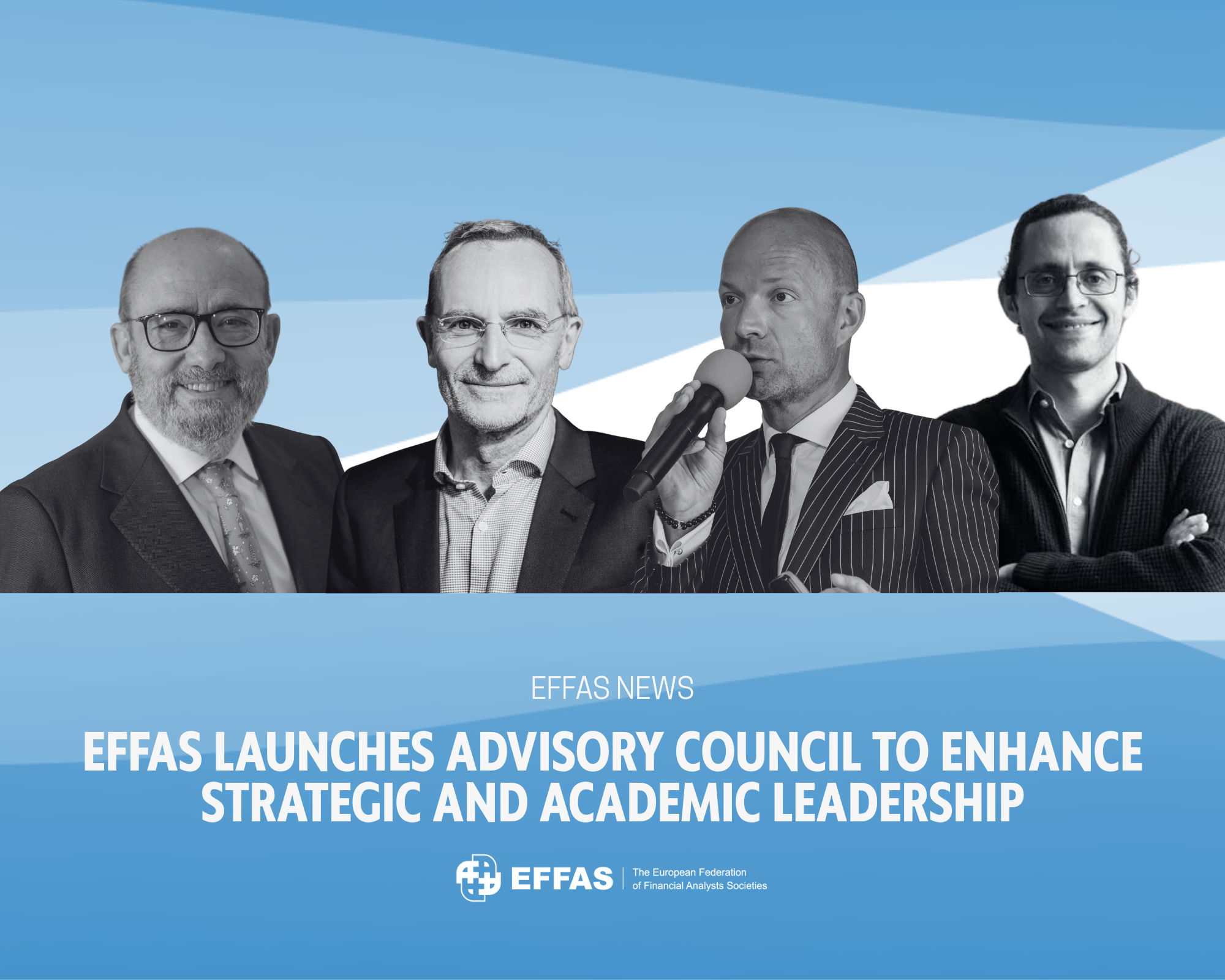EFFAS Commission on ESG - Position Note 2
Engagement – Some good practices to remember
Engagement is one of the three components of stewardship alongside (more or less regular) dialogue with issuers and voting policy. Engagement is core, accessible to all types of investors, whether active or passive and oriented short term (hedge fund) or long term (long only, pension fund).
The equity investor, the shareholder, is naturally the most legitimate to practice engagement. However, the debt investor, the creditor, can also be involved because the objectives and practices of engagement can come together. In all cases, it is a key practice of the long-term oriented active investor; to be distinguished from the more short-term oriented activist investor.
1 – What is engagement?
Engagement is a much more structured and demanding form than dialogue. Dialogue with an issuer consists of contacts, more or less regularly, in an individual meeting (“One on one”) or in a group meeting during, for example, a financial and/or ESG roadshow. It can be limited to phone or email exchanges with minimal formality. The dialogue concerns both issuers in which an investment has been made and simply a potential investment in the future. In order to optimize resources, engagement focuses generally on significant investments made for the long term. Improving ESG and/or financial performance is the primary objective for selecting an issuer. The engagement can remain private or become public and take many forms such as newsletters, press release, letters, investor initiatives, public campaigns…
Engaging with an issuer requires a rigorous and formalized approach, which includes the following steps;
- Identification of the targeted area, financial and/or sustainability,
- Making the choice of an individual or collective engagement, collective engagement allowing resources to be pooled and impact to be increased (mass effect),
- Characterization of its nature, subject of transparency, operational and/or strategic for example,
- Identification of the targeted areas of improvement, factual and measurable, transcribed into Key Performance Indicator (KPI),
- Designation of a corresponding calendar, which can generally vary between 12 months and 5 years,
- Names of contacts met at the issuer and any other potential stakeholders,
- Monitoring of interviews, visits, responses provided, progress and lack of progress, etc.
- Defining an escalation process (public disclosure, participation to the co-filling of resolution, partial or complete disinvestment…) and its application, if necessary,
- Formalized closure of the engagement; success, partial success, failure…
2 – Why engage?
Engagement has several reasons, the main ones being as follows:
- It aims, through the holding of securities in shares and/or bonds, to influence issuers for an improvement in terms of transparency (training efforts for the employees for instance), operational performance (capex invested in renewable electricity for instance) or even strategic development (decarbonization of the business model of a utility for instance). The final objective is the creation of shared long-term value for the investor and other relevant stakeholders.
- It allows a better understanding and knowledge of the issuer involved, which will indirectly contribute to improving, in all cases better control, the return/risk couple of the investment studied.
- It responds to the establishment of regulations and voluntary codes requiring at least reporting on dialogue, engagement and voting policies. This is the case within the European Union and in other countries such as Japan and the UK. Let us recall in this context that the second of the six principles of the PRI militates in favor of engagement.
- At least in Europe, it is an integral part of the investor’s fiduciary responsibility, of his obligations towards his clients and/or beneficiaries.
- It is a key tool as a responsible investor for passive management as well as for universal investors such as large pension funds (Norwegian Sovereign Fund, GPIF in Japan, etc.) which can customize or not their engagement policy.
3 – 10 Best key practices to know:
Engagement cannot be decreed. It must be conducted in a rigorous and professional manner. Below we offer a non-exhaustive list of 10 good practices;
- Formalize and make public the engagement policy,
- Define a process for identifying and selecting engagements to be carried out as a priority,
- Combine different expertise for each engagement such as financial analysts, ESG analysts and equity and/or debt portfolio managers,
- Formalize one or more objectives, always factual and if possible quantitative,
- Define a corresponding consistent and precise calendar,
- Report regularly on the different stages of progress or not within the framework of a dedicated committee chaired by a key manager of the investment company (CIO, CEO, etc.) who will validate the launches of engagements and their conclusions,
- Formalize an escalation policy, which can take many forms (public communication, filing of resolution, partial or total divestment, etc.),
- Measure the degree of success of the engagement at the time of its closure,
- Link dialogue, engagement and voting policy which complement each other and must not be treated in silos,
- Publish an engagement report at least annually.
4 – How do you measure the success of engagement?
The success or failure of engagement must be measured in particular with regard to the human and financial resources devoted to engagement and stewardship activities more generally. Having formalized at least one key success indicator upstream, investors can qualify the success of their commitment with qualifications such as success, partial success, failure, etc.
It should be noted that the indicator chosen to measure success determines the success rate. For example, in the vast majority of cases, a return from an issuer simply indicating that “an investor’s request has been taken into account” without any further details in the case of a commitment can be guaranteed. On the other hand, success when the aim is to turn the company’s strategy around is rare.
Finally, do not forget engagement is a question of quality and not quantity. Count the number of engagement and not the number of meetings. One should also avoid inflation in reporting on the number of engagements made, which is often confused with the number of dialogues conducted, with the difference in practice often being a factor of 1 to 20… Another bad practice is the fact that some investors report on the total number of commitments made by an initiative of which they are a member (Climate Action 100, for example) versus the actual number in which they are actively involved. The difference in this case is about a factor of 1 to 50…
5 – Key success factors for engagement
Engagement is a difficult exercise. However, there are a few key factors that contribute to a successful engagement;
- Investor’s weighting in the issuer’s shareholding and/or debt,
- Whether the target issuer’s shareholder base is dispersed (non-controlled, controlled, family-owned). In practice, the management of a company with open capital will be more attentive to an engagement from a minority investor, especially if it is likely to bring together other minority investors…,
- Credibility of the engagement, based on the investor’s precise knowledge and understanding of all aspects of the issuer: business model, financials, sustainability, etc.
- Local dimension’s effectiveness (a German investor engages a German issuer, etc.),
- Relevance, clarity and transparency of the objectives of the engagement for both the investor and the issuer involved,
- Investor’s experience curve in terms of engagement. This experience can be built and strengthened through participation in collective commitments and specialized coalitions (Access to Medicine, Climate Action 100, FAIRR, Nature 100+, PRI, ShareAction, etc.).
These key success factors must naturally be taken into account when prioritizing engagement.
Conclusion
Part of EFFAS’ discussion is engagement, which serves as a cornerstone for sustainable finance. EFFAS is committed to providing clarity and actionable insights through the EFFAS ESG Position Notes, encouraging financial professionals to share experience and best practices.
EFFAS remains dedicated to supporting financial analysts and the wider financial community in navigating the evolving landscape of sustainable finance, promoting transparency, consistency, and informed decision-making in pursuit of a more sustainable and inclusive economy.
For more detailed information visit the official pages on the European Commission’s website:
https://eur-lex.europa.eu/EN/legal-content/summary/shareholder-rights-directive.html
—————————————-
The EFFAS CESG was established in October 2007 to facilitate the integration of ESG factors into investment processes. Composed of investment professionals from leading European and global sell-side and buy-side firms, including fund managers, financial analysts, and equity specialists, the CESG has been mandated by EFFAS to achieve several objectives. These include establishing and coordinating EFFAS’s position on ESG reporting, measurement, and valuation; consolidating ESG expertise among European investment professionals; extending ESG efforts beyond individual EFFAS member companies; engaging in policy, academic and industry initiatives on ESG issues; organizing European-level conferences on ESG issues; and representing EFFAS in international conferences and projects related to ESG issues. CESG serves as a reference and networking Centre for ESG integration efforts of investment professionals across Europe.
CESG Co-Chairs: Jean-Philippe Desmartin (SFAF) and Frank Klein (DVFA).
https://effas.com/commissions/effas-commission-environment-social-and-governance-cesg/
About EFFAS
EFFAS is a Not-for-profit organisation set up in 1962 with 14 national member associations in Europe, representing more than 16,000 Financial analysts, Asset managers, pension fund managers, corporate finance specialists, risk managers, treasurers among many other professional profiles from the investment profession. EFFAS is a certification body for finance with over 24,400 certificate holders worldwide.
Chair of the EFFAS Executive Management Committee (EMC): Dr. Jesus Lopez Zaballos.
For any queries, please refer to:
Alvaro Wagener Diez | Marketing & Communications Manager
EFFAS e.V.
Sophienstraße 44, DE 60487 Frankfurt am Main.
a.wagener@effas.com
Phone: +49 69 98959519 – Fax: +49 69 98957529
website: www.effas.com







